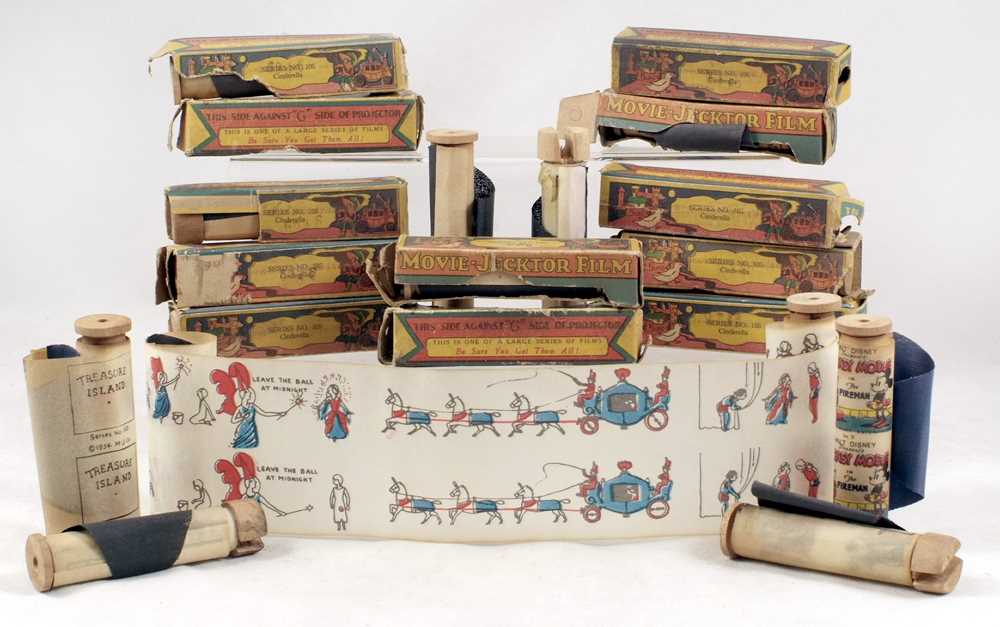Katalognummer: CA0420-251 A RARE GROUP OF FOUR FEMALE MUSICIANS FROM KUCHA, SUI - EARLY TANG DYNASTY China, 7th century. Each of the four well-modeled pottery figures shows a seated musician, wearing a long shawl draped over the shoulders of her low-cut bodice dress that falls in graceful folds around her knees. One plays cymbals, one Pan pipes, one a lute and one a zither. The facial features are delicately sculpted in a serene expression and the hair is dressed in a slightly eccentric cloth-wrapped topknot. Finely painted in red, blue and black pigment. (4) Provenance: A Swiss private collection. Galerie Zacke, Vienna, 2002. Dr. Mons Fischer, acquired from the above. A seasoned private collector of modern and contemporary art, Dr. Mons Fischer has also acquired fine Chinese works of art since the 1980s, eventually building one of the most important collections of its kind in Austria. Condition: Some repair and touchups as generally expected from dynasty excavations with an age of 1300 years or more. Losses, fissures and encrustations. Three of the four statues each with two drilled holes from sample-taking. Overall very good condition. Scientific Report for the cymbal player: A thermoluminescence analysis report issued by Oxford Authentication on February 11th, 2020, based on sample number C120a72, sets the firing date of two samples taken at 900 – 1500 years ago. A copy of the report, issued by Oxford Authentication, is accompanying this lot. Scientific Report for the Pan pipes player: A thermoluminescence analysis report issued by Oxford Authentication on February 6th, 2020, based on sample number C120a63, sets the firing date of two samples taken at 900 – 1500 years ago. A copy of the report, issued by Oxford Authentication, is accompanying this lot. Scientific Report for the zither player: A thermoluminescence analysis report issued by Institut für Konservierungswissenschaften und Restaurierung an der Universität für Angewandte Kunst Wien on June 18th, 2002, based on sample number VHTL-P651, sets the firing date of two samples taken at 1905 years ago, with a possible deviation of +/- 25%. A copy of this report is accompanying this lot. Weight: circa 1.9 kg Dimensions: Height between 18 and 21.5 cm Kucha (or Kuche) was an ancient Buddhist kingdom located on the branch of the Silk Road that ran along the northern edge of the Taklamakan Desert in the Tarim Basin and south of the Muzat River. Literature comparison: These four figures are similar to a group of ten seated female court musicians in the Shoso-in, Japan, illustrated by Ryoichi Hayashi in The Silk Road and the Shoso-in, New York/Tokyo, 1975, p. 96, fig. 103. Three similar painted pottery figures of seated female court musicians illustrated by J. Baker in Appeasing the Spirits: Sui and Tang Dynasty Tomb Sculpture from the Schloss Collection, Hofstra Museum, Hofstra University, 1993, p. 18, no. 9, are described as wearing Kuchean fashions, and representing the Kuchean modes of music and entertainment that were popular during the Sui and early Tang periods. The same costume and Kuchean hair style can also be seen on a group of standing figures illustrated p. 17, nos. 6 and 7. In discussing a group of nine similarly attired and coiffed standing figures of female musicians illustrated in China: A History in Art, New York, 1979, p. 132 (top), the authors, B. Smith and Wango Weng, note that female musicians from Chinese Turkestan played for the court, and that “musicians from Kucha in Central Asia probably exerted the most influence” at court. Auction result comparison: Compare with a closely related set of two musicians at Christies New York in Fine Chinese Ceramics & Works of Art part I, 17 - 18 March 2016, lot 1479, sold for USD $27,500. 一組四個彩繪樂伎陶俑,隋代至唐代初期 中國,七世紀。四個造型精美的人物陶俑,顯而易見都是樂傑,曲腿坐在地上,低胸緊身連衣裙的肩膀上披著一條長披肩,膝蓋上的褶皺優美。她們分別演奏銅钹、古箏、琵琶和排簫。五官雕刻精緻,表情寧靜,頭髮則梳成偏心的包裹式髮髻。紅色、藍色和黑色顏料。 來源:一個瑞士私人老收藏。維也納Zacke藝廊,2002年。Dr. Mons Fischer購於上述藝廊。Dr. Mons Fischer是一位經驗豐富的現代和當代藝術私人收藏家,從1980年
Katalognummer: CA0420-251 A RARE GROUP OF FOUR FEMALE MUSICIANS FROM KUCHA, SUI - EARLY TANG DYNASTY China, 7th century. Each of the four well-modeled pottery figures shows a seated musician, wearing a long shawl draped over the shoulders of her low-cut bodice dress that falls in graceful folds around her knees. One plays cymbals, one Pan pipes, one a lute and one a zither. The facial features are delicately sculpted in a serene expression and the hair is dressed in a slightly eccentric cloth-wrapped topknot. Finely painted in red, blue and black pigment. (4) Provenance: A Swiss private collection. Galerie Zacke, Vienna, 2002. Dr. Mons Fischer, acquired from the above. A seasoned private collector of modern and contemporary art, Dr. Mons Fischer has also acquired fine Chinese works of art since the 1980s, eventually building one of the most important collections of its kind in Austria. Condition: Some repair and touchups as generally expected from dynasty excavations with an age of 1300 years or more. Losses, fissures and encrustations. Three of the four statues each with two drilled holes from sample-taking. Overall very good condition. Scientific Report for the cymbal player: A thermoluminescence analysis report issued by Oxford Authentication on February 11th, 2020, based on sample number C120a72, sets the firing date of two samples taken at 900 – 1500 years ago. A copy of the report, issued by Oxford Authentication, is accompanying this lot. Scientific Report for the Pan pipes player: A thermoluminescence analysis report issued by Oxford Authentication on February 6th, 2020, based on sample number C120a63, sets the firing date of two samples taken at 900 – 1500 years ago. A copy of the report, issued by Oxford Authentication, is accompanying this lot. Scientific Report for the zither player: A thermoluminescence analysis report issued by Institut für Konservierungswissenschaften und Restaurierung an der Universität für Angewandte Kunst Wien on June 18th, 2002, based on sample number VHTL-P651, sets the firing date of two samples taken at 1905 years ago, with a possible deviation of +/- 25%. A copy of this report is accompanying this lot. Weight: circa 1.9 kg Dimensions: Height between 18 and 21.5 cm Kucha (or Kuche) was an ancient Buddhist kingdom located on the branch of the Silk Road that ran along the northern edge of the Taklamakan Desert in the Tarim Basin and south of the Muzat River. Literature comparison: These four figures are similar to a group of ten seated female court musicians in the Shoso-in, Japan, illustrated by Ryoichi Hayashi in The Silk Road and the Shoso-in, New York/Tokyo, 1975, p. 96, fig. 103. Three similar painted pottery figures of seated female court musicians illustrated by J. Baker in Appeasing the Spirits: Sui and Tang Dynasty Tomb Sculpture from the Schloss Collection, Hofstra Museum, Hofstra University, 1993, p. 18, no. 9, are described as wearing Kuchean fashions, and representing the Kuchean modes of music and entertainment that were popular during the Sui and early Tang periods. The same costume and Kuchean hair style can also be seen on a group of standing figures illustrated p. 17, nos. 6 and 7. In discussing a group of nine similarly attired and coiffed standing figures of female musicians illustrated in China: A History in Art, New York, 1979, p. 132 (top), the authors, B. Smith and Wango Weng, note that female musicians from Chinese Turkestan played for the court, and that “musicians from Kucha in Central Asia probably exerted the most influence” at court. Auction result comparison: Compare with a closely related set of two musicians at Christies New York in Fine Chinese Ceramics & Works of Art part I, 17 - 18 March 2016, lot 1479, sold for USD $27,500. 一組四個彩繪樂伎陶俑,隋代至唐代初期 中國,七世紀。四個造型精美的人物陶俑,顯而易見都是樂傑,曲腿坐在地上,低胸緊身連衣裙的肩膀上披著一條長披肩,膝蓋上的褶皺優美。她們分別演奏銅钹、古箏、琵琶和排簫。五官雕刻精緻,表情寧靜,頭髮則梳成偏心的包裹式髮髻。紅色、藍色和黑色顏料。 來源:一個瑞士私人老收藏。維也納Zacke藝廊,2002年。Dr. Mons Fischer購於上述藝廊。Dr. Mons Fischer是一位經驗豐富的現代和當代藝術私人收藏家,從1980年







.jpg)



.jpg)



Testen Sie LotSearch und seine Premium-Features 7 Tage - ohne Kosten!
Lassen Sie sich automatisch über neue Objekte in kommenden Auktionen benachrichtigen.
Suchauftrag anlegen